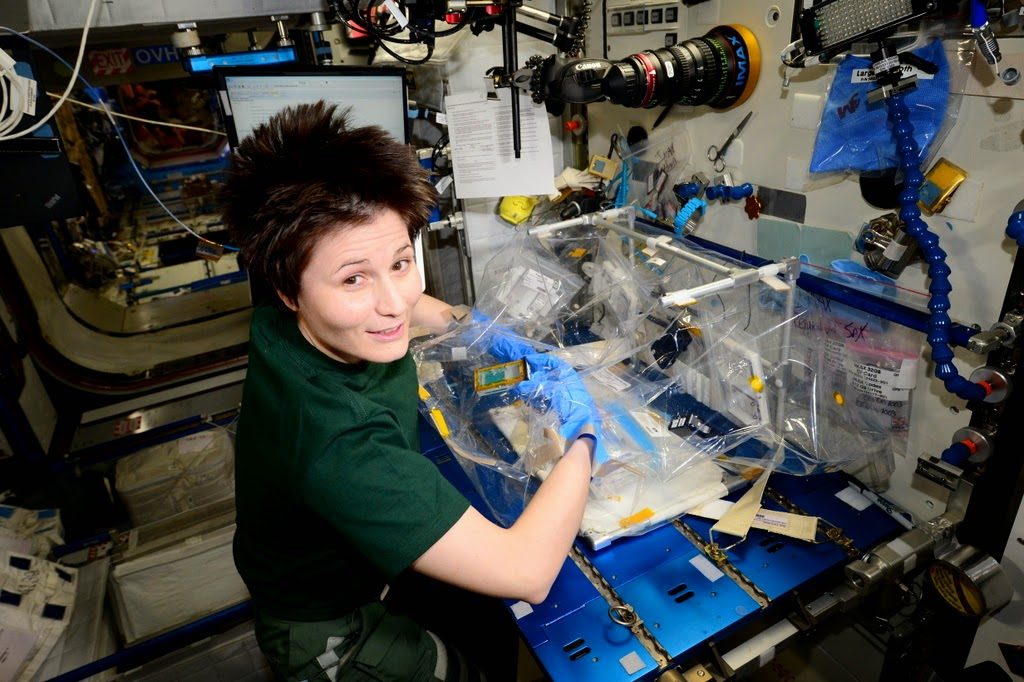This has been one of those weeks when the subject of the experiment is often… me.
Human physiology has definitely been very present on my science schedule, starting already on the weekend, when I got to do some data gathering while sleeping! In fact, Dragon has brought me a very fancy night wardrobe: a vest for the Wearable Monitoring experiment that I had to wear for two nights in a row for the first data gather. This vest has been custom-made for me and is a very tight fit, because it integrates instruments that need to be adherent to the body: electrodes, for a “classic” electrocardiogram, and a three-axis accelerometer to monitor the mechanics of the heart, namely the opening and closing of the heart valves. The hypothesis to be tested here is that tiny variations in the cardiac functions cause micro-awakenings that compromise sleep quality on ISS. Although I have to say, from a purely subjective and non-quantitative point of view of course, that I feel like I sleep great up here!
Early in the morning on Monday it was also time for the first session of Drain Brain. Actually, we already had an ultrasound session early on in the mission, but for this particular set of measurements we had to wait for the replacement hardware to be delivered on Dragon, following the loss of the Orbital-3 mission. Specific instruments for Drain Brain include three strain-gauge pletismoghraphs, which look like collars of a stretchable material, as you can see in the picture. They are actually sensors able to measure blood flow in the veins in a very simple and non-invasive manner, which is not dependent on the skills and interpretation of the operator, as is the case with ultrasound. While wearing these collars on my neck, arm and leg, I performed a series of breaths at 70% of my lung capacity, either remaining still or stretching and flexing my hand or my ankle. While doing that, I was breathing into our Pulmonary Function System and the software, via a graphic interface, was giving me instructions on when to start exhaling or inhaling. The main goal of the experiment is to study how the return of blood from the head to the heart changes in space, since we don’t have gravity effects helping with that. It’s something that we know little about for now and a better understanding of these circulatory mechanisms could potentially help in understanding some degenerative diseases of the brain.
After Drain Brain, I moved on to the second in-flight session of the Cardio Ox experiment, taking ultrasound images of the carotid and brachial arteries and Doppler measurements of blood flow. And to wrap up the human physiology day, I also did another data collection for Skin-B, that I have told you about before. And since many of these experiments need a matching sample collection, on Tuesday I performed a 24-hour urine sample collection and “Terry the Vampire” (a close friend of “Terry Scissorhands” the hairdresser) got do draw blood from me.
But hey, as you know, there’s not only us humans on ISS! No, no, don’t get excited, I’m not aware of any stow-away alien living onboard nor of any UFO flying combat air patrols in the area, but we have of course our friendly fruit flies! Some of the cassettes with fly and larvae did end up in the freezer at this point, but I put more cassettes in the centrifuge and static position of their dedicated facility and this multi-generation project is continuing on. For some of the fixation operations I got to build and use a disposable glovebox, as you can see in the picture: I didn’t even know we had those onboard, the Space Station is always full of surprises!
Futura mission website (Italian): Avamposto42
avamposto42.esa.int
(Trad IT) Traduzione in italiano a cura di +AstronautiNEWS qui:
https://www.astronautinews.it/tag/logbook
(Trad FR) Traduction en français par +Anne Cpamoa ici:
https://spacetux.org/cpamoa/category/traductions/logbook-samantha
(Trad ES – Currently not updated) Tradducción en español aquí:
https://laesteladegagarin.blogspot.com.es/search/label/SamLogBook
23/01/2015





